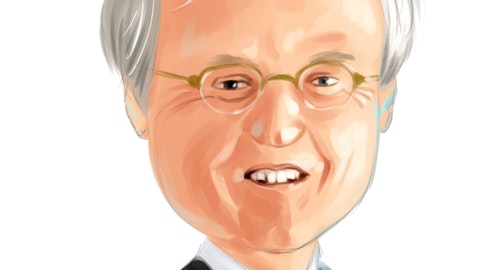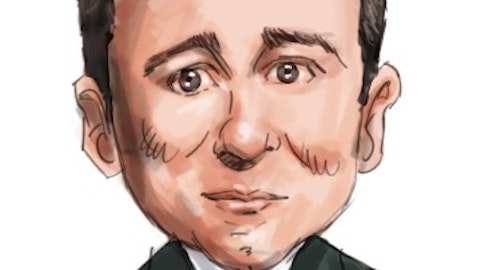Great Southern Bancorp, Inc. (NASDAQ:GSBC) Q3 2023 Earnings Call Transcript October 19, 2023
Operator: Hello and welcome to Great Southern Bancorp, Inc. Third Quarter 2023 Earnings Conference Call. At this time, all participants are in a listen-only mode. After the speakers’ presentation, there will be a question-and-answer session. [Operator Instructions] I would now like to hand the conference over to Kelly Polonus. You may begin.
Kelly Polonus: Thank you. Good afternoon, and thank you for joining us for our third quarter 2023 earnings call. The purpose of this call today is to discuss the company’s results for the quarter ending September 30, 2023. Before we begin, I need to remind you that during the course of this call, we may make forward-looking statements about future events and financial performance. These statements are subject to a number of factors that could cause actual results to differ materially from the results anticipated or projected. For a list of some of these factors, please see the forward-looking statements disclosure in our third quarter earnings release and other public filings. President and CEO, Joe Turner and Chief Financial Officer, Rex Copeland are on the call with me. I’ll now turn the call over to Joe.
Joseph Turner: All right. Thanks, Kelly and good afternoon, everybody. We appreciate you joining us today for our third quarter earnings call. Our third quarter performance was solid, but down a bit as you saw, as we continue to navigate through a challenging operating environment. We earned $1.33 per diluted common share or $15.9 million compared to $1.46 per diluted common share or $18.1 million during Q3 of 2022. Earnings performance ratios were again solid with an annualized return on assets of 1.11% and an annualized return on equity of 11.47%. We mentioned on our last couple of calls some anticipated headwinds that we would face related to net interest margin. Net interest margin did decline to 3.43% for the third quarter compared to 3.96% for the same period in ’22, and 3.56% for the second quarter of ’23.
The margin contraction primarily resulted from increasing interest rates on all deposit types during the third quarter and a full quarter’s impact from net settlements related to two interest rate swaps. Like many banks in 2023, we have experienced much higher deposit costs compared to 2022 reflective of increasing market interest rates and significant competition for deposits. Deposit costs again moved higher in the third quarter of ’23 but the pace of increases moderated compared to the second quarter. Rex will provide some color around our funding costs and deposit mix during his presentation. Also as you know, we had an ongoing significant professional fee expense item, totaling about $900,000 related to training, and implementation costs of the upcoming core systems conversion.
As far as liquidity and capital, our liquidity and capital positions continue to be strong. At the end of September ’23 available secured funding lines through the Home Loan Bank and the Federal Reserve Bank and on-balance sheet liquidity were approximately $2.2 billion. As noted last quarter, our company’s deposit base is diverse, and by customer type and geography and have a low level of uninsured deposits, approximately 16% of our total deposits are uninsured, excluding internal subsidiary account. Total stockholder’s equity decreased by $1.4 million from the end of ’22 and decreased more substantially by about $14.6 million from June of ’23 as a result of increased unrealized AOCI losses due to market interest rate increases in the third quarter of ’23.
Importantly though the retained earnings component of our stockholder’s equity has increased $20.8 million, during the nine months ended September 30, 2023. Our capital remains substantially above regulatory well-capitalized thresholds, and our tangible common equity ratio was 9.1% at September 30, ’23. In the third quarter, the company declared a $0.40 per share common dividend in addition in our effort to enhance long-term stockholder value, the company continued to repurchase shares of common stock during the quarter. We bought back almost 107,000 shares at an average price of $50.52. The dividend and stock repurchases combined reduced stockholder — stockholder’s equity by about $10.1 million during the third quarter. At September 30, 2023 about 801,000 shares were available in our stock repurchase authorization.
During the third quarter, new loan production and general activity was down compared to 2022 as expected. Total outstanding loan balances modestly grew by about $58 million since the end of 2022. Growth primarily came from the multi-family loan segment, much of this from projects completed and moved from the construction category to multifamily and commercial business loans, partially offset by a reduction in the commercial real estate category. At the end of September 2023, the pipeline of loan commitments and unfunded lines declined to about $1.4 billion, including $922 million in the unfunded portion of construction loans. For comparison, at the beginning of 2023, loan commitments and unfunded lines totaled about $2.1 billion with $1.4 billion in unfunded construction lines.
For more information about our loan portfolio, I’ll remind you of our quarterly loan portfolio presentation that we have on file with the SEC and is available on our Investor Relation site under the Presentations link. Our quarterly loan presentation provides helpful information regarding our loan portfolio mix, by type and geography. Overall, our commercial portfolio is strong, diverse and performing well. As expected, we are experiencing some payoff activity. Overall, credit quality metrics remained strong during the quarter, non-performing assets to total assets were 0.19% at September 30, 2023 decreasing by 1 basis point from June 30, 2023. Delinquencies in our loan portfolio continue to be at historically low levels, more information about our non-performing and potential problem loans are included in our earnings release.
That concludes my prepared remarks. At this time, I will turn it over to our CFO, Rex Copeland.
Rex Copeland: All right. Thank you, Joe. Appreciate that. I’ll just start with the discussion about net interest income and margin. And I’ll begin with just a general comment that not maybe unlike others, our net interest income comparisons in the third, and probably the fourth quarters this year will show declines from the same periods in 2022. Market interest rates obviously increased pretty significantly in 2022 and we were able to increase rates on assets quicker than liabilities last year, and so we achieved for us peak net interest income and net interest margin in the second half of 2022 and spilled over little bit into the first quarter of 2023. But since that time some of our net interest income and margins have come down for rate as we’ve talked about a little bit last quarter and I’ll discuss a little bit today.
Net interest income for the third quarter of 2023 decreased $6.2 million or approximately 11% to $46.7 million compared to $52.9 million for the third quarter of 2022. And that was really driven by increasing interest rates on deposit, various deposit types during the third quarter of ’23, and also the negative impacts of interest rate swaps which began settling in the second quarter of 2023, and would not have been affecting the quarters in 2022. Those swaps in particular had a negative impact of $2.7 million in the third quarter of ’23. Net interest income was $48.1 million for the second quarter of 2023, so we had a decrease in net interest income between Q2 and Q3 this year of about $1.4 million. The negative impact of those newly settling interest rate swaps was about $1 million more in the third quarter of this year versus the second quarter of this year.
The company’s net interest income was negatively impacted in the third quarter by high level of competition for deposits across the industry and in our local markets. The company also had a substantial amount of time deposits maturing at relatively low rates in the second quarter of 2023, as we discussed before and now these time deposits were renewed at higher rates or we had to replace without external funds and the impact of that was fully there for the all of Q3 versus a portion in Q2. In addition, we had — in the first quarter of 2023, we experienced higher than normal reduction in balances of non-interest bearing deposits. That outflow of non-interest bearing deposits moderated in the second quarter, but increased a bit again in Q3 of 2023.
Customer balances in both non-interest bearing checking and interest-bearing checking accounts have fluctuated in the first nine months of this year. As market interest rates for certain checking account types and time deposit accounts have increased, some customers have chosen to reallocate funds into relatively higher rate accounts. The company has more low rate time deposits maturing in the fourth quarter of this year, a little bit more than what matured in the third quarter, but not as much as what we had maturing and repricing in the second quarter of 2023. The difference in the rate being paid on those time deposits maturing in the fourth quarter of ’23 versus the expected rate that will be paid on renewal of those is not as great as it was in the, earlier in the second quarter of this year, but there should be some increase, most likely.

A smiling mother with her children accessing an ATM, demonstrating the company’s easy banking services for customers. Editorial photo for a financial news article. 8k. –ar 16:9
Just to give you an idea and we noted this in our release, but subsequent to September 30, we’ve got time deposit maturities over the next 12 months to kind of break down as follows. Within three months about $354 million with a weighted average rate of 3.16%, within three to six months another $352 million with a weighted average rate of about 3.88%. And then within six months to 12 months about $350 million with a weighted average rate of 3.93%. So we kind of think that based on the current replacement rates that we envision on that, they’ll probably be replacing at rates between maybe 4.25% to 4.75%. Besides the higher funding costs on deposits, net interest income was also negatively affected by the company’s interest rate swaps, as I mentioned and as described in our earnings release.
If market interest rates remain near with their current levels, the company’s interest rate swaps will continue to have a negative impact on net interest income. Based on the interest rates on these swaps at September 30, the negative impact of all the interest rate swaps that we have combined in the fourth quarter of ’23 is expected to be approximately $3.7 million. The negative impact of all of the swaps combined in the third quarter of ’23 was about $3.5 million. And then as a reminder, again one of those swaps will terminate March 1, 2024, that interest rate swap itself had a negative impact on net interest income of $2.8 million, and a negative impact on net interest margin of 21 basis points in the third quarter of 2023. It’s expected that again rates being where they are, it will have a negative impact to net interest income of about $2.9 million in the fourth quarter of ’23, and then $1.9 million in the first quarter of ’24, and then subsequent to the first quarter, no impact in subsequent periods.
As Joe mentioned earlier, net interest margin was 3.43% in the third quarter of ’23 compared to 3.96% in the same period in 2022, which was a decrease of about 53 basis points. And it also decreased about 13 basis points compared to net interest margin of 3.56% in the second quarter of 2023. In comparing the couple of yield items in there and rates, between the ’23 and ’22 third quarter periods, the average loan yield increased about 113 basis points, while the average rate on interest-bearing deposits increased about 203 basis points. Joe mentioned liquidity briefly earlier, and I’ll just say a couple of more things about that. Our liquidity levels are — continue to be resilient, we have readily available funding sources, totaling about $2.2 billion at the end of September of ’23 with about $1.1 billion almost availability at Home Loan Bank.
So we have those funds readily available, should we need anything there. We also have some unpledged securities that we have — that we could pledge if we chose to do that, and that’s over $500 million worth of those. At September 30, ’23 total deposits were nearly $4.9 billion, during the three months ended September 30, ’23 the company’s total deposits increased about $27 million. Total brokered deposits decreased less than $1 million in that time frame. Time deposits generated through our banking centers and corporate services networks increased $21 million and time deposits generated through internet channels decreased $5 million in the third quarter. And then interest bearing checking balances increased $49 million or about 2.3% and non-interest bearing checking balances decreased $38 million or about 3.9% during the third quarter of 2023.
Non-interest income items in the quarter, we really didn’t have any variance items there. The total decrease was about $132,000 compared to the third quarter of 2022, no real large component changes in the quarter comparisons. For the year-to-date, we did have a few things that changed or I’m sorry, for the quarter for non-interest expense, we did have expense overall increased about $799,000 to $35.6 million. Some of the components in there that had a little bit larger variances from a year ago quarter. Salaries and employee benefits increased about $697,000 from the previous year quarter. Portion of this is just normal annual merit increases in — in various lending operations areas. In 2023, some of those were a little bit larger than maybe they were in previous periods.
In addition, compensation costs related to originated loans which we defer under accounting rules, a portion of those and that decreased by $233,000 in comparing the two periods. So that resulted in higher expense levels in the 2023 period as loan volume originations were lower this year compared to 2022. Occupancy expense, we did have an increase there this year’s quarter versus previous year quarter of about $531,000. We had various components of computer license and support expenses which we had implemented during this period that maybe we had kind of got to end of life last year, and didn’t have the same level of expense. That increased our cost by about $333,000 comparing the two periods and then we also had some just various repairs and maintenance expenses throughout our network that added about 106,000 more than the previous year.
The next two items, there’s a couple of things. I’ll mention on those, and then a little bit of additional clarification on some things on that. So total insurance expense increased $498,000 from the prior year quarter. This was primarily due to the previously announced increases in deposit insurance rates for FDIC deposit insurance fund coverage. We will continue to have a little bit extra probably in the fourth quarter, we estimate that there’ll be a little higher than normal expense again of about $180,000 that was really in Q3 and probably will continue in Q4 but after that, there shouldn’t be that extra level in there, so starting in Q1, we should be caught up with the deposit insurance fund increase level. So going forward, it should just be a normal amounts after Q4.
Legal audit professional fees, we did have a higher — I’m sorry, those decreased by $390,000 from the prior year. In the previous year, we had $372,000 of one-time fee expenses related to the origination of some interest rate swaps that we did there. And then one other thing I’ll point out, it really wasn’t a large amount. But probably in the third quarter, there was about $150,000 maybe of non — what I call non-recurring type expenses that we didn’t necessarily call out in the release. But there were just some fees in there for some services that were provided to us that we do periodically but not certainly every quarter. So, the efficiency ratio then for the third quarter was 65.13% compared to 57.09% for the same quarter in 2022 as expenses increased a bit, and net interest income and the denominator decreased.
Provision for credit losses. During the third quarter ’23, we didn’t record any provision expense on our outstanding loan portfolio. And that compared to $2 million of provision expense during the same period in 2022. Also for the three months ended September 30, ’23, the company did record a negative provision for losses on unfunded commitments of $1.2 million compared to a provision expense of $1.3 million for the three months ended September 30, 2022. As we mentioned before, our level of — total level of unfunded commitments has come down from the previous quarter as we were able to relieve some of the reserve on that. Total net charge-offs were $99,000 for the three months ended September 30, ’23, that compared to $297,000 of net charge-offs in the three months ended September 30, 2022.
And at the end of the third quarter of ’23, the allowance for credit losses, as a percentage of total loans was 1.40%. Income taxes in the period for the three months ended September 30, ’23 and ’22, the company’s effective tax rate was 21.5% this year, and 20.5% in the quarter last year. These effective rates were near or below the statutory federal rate of 21% due primarily to utilization of investment tax credits, and certain tax-exempt investments and loans, which reduced our effective tax rate a bit. The company expects its effective tax rate both combined federal and state will be about 20.5% to 22.0% in future periods and will be affected by the overall level of earnings and the utilization of these tax credits and tax exempt income and then also it is affected a bit by state tax expenses.
We estimate those continually and they do evolve over time. And so those can affect the overall effective tax rate, as well as we — as we look through some of those various state taxing authority expenses. So that concludes the prepared remarks that we have today. And at this time, we will entertain questions and I’ll ask our operator please to once again remind the attendees of how to queue in for questions.
See also 16 Best Investing Podcasts in 2023 and Abrams Capital 13F: 10 Best Value Stocks To Buy.
Q&A Session
Follow Great Southern Bancorp Inc. (NASDAQ:GSBC)
Follow Great Southern Bancorp Inc. (NASDAQ:GSBC)
Receive real-time insider trading and news alerts
Operator: Thank you. [Operator Instructions] Our first question comes from the line of Andrew Liesch with Piper Sandler. Your line is open.
Andrew Liesch: Hey. Good afternoon, everyone. Just want to drill in on the margin here, it sounds like you had more CD repricing here and based on the commentary in the release and you’re in today, it seems like maybe 13 basis points might be a little too steep further — for the fourth quarter. But I’m just curious, how you guys are thinking about the margin this quarter and then should it stabilize beyond that, I know you have some more CD repricing but as the Fed seemingly done with raising rates, we see some stabilization in the margin as well.
Joseph Turner: Yeah. I mean, I’ll take a shot and then Rex can jump in. Andrew, I mean I think, we are getting — it’s a little bit hard to say, because every time you think things are going to stabilize, then you see more deposit specials and those kinds of things. But you see with our CD repricing, this is kind of the last point at which the deposits that we’re repricing, the CDs that we are repricing are substantially below market rate. So I mean, the other — the stuff that we repriced that’s three to six months out, six to 12 months out, maybe slightly below, but it’s not as far below. So it won’t be as impacting. Of course, we think the interest bearing checking or non-time interest bearings to should kind of reprice continually. So you shouldn’t see that and we do have fixed rate assets that are repricing that — that should help. But it’s hard to — it’s hard to zero in on that exactly.
Rex Copeland: Yeah. I mean we are seeing, it kind of calmed down for a while, but we are seeing some banks in different locations that we compete with that are showing rates above 5%. I mean it’s just kind of a base rate on certain products, CDs primarily, certain term CDs and things like that. So kind of — that kind of comes and goes. And so we do see some heightened competition in some ways in some places. I think that like I said it in the next, in the fourth quarter of this year, those $350 million-ish of CDs are going to reprice. Those are sitting there at overall rate of about 3.16%. So there is — there is some space to go there. We will probably be repricing those in the low 4s maybe or something like that. But like Joe said beyond that and those rates are in the high threes, almost to 4%.
So it does seem like after the fourth quarter that the difference in rate, all things staying like they are today would be less than what we saw, so like in the second quarter this year, I mean we were repricing stuff that was in the twos back up into the 4% range.
Joseph Turner: So the — I mean, I would say, it feels better, Andrew, but it’s just hard to zero in on it exactly.
Andrew Liesch: Got it. Well certainly that repricing gap is narrowing. You mentioned that the fixed rate assets that are repricing now, I guess. Do you have handy that percentage of or the dollar amount of fixed rate assets that have yet to benefit from the Fed’s rate hikes since the beginning of last year?
Joseph Turner: We don’t — I don’t have it and I don’t think Rex does either, Andrew, but we have good disclosures in our K and that we have in our Qs as well about repricing, Rex?
Rex Copeland: The 10-K that we filed at the end of the year, Andrew, would have a — there’s a table — at the end of the MD&A section, there’s a — there’s two tables, one it’s the maturity table by year for the first five years and then beyond and then there’s a repricing table in there. So, and we do have fixed rate loans and variable-rate loans broken out in two separate lines in there. So you can get an idea. I mean, I don’t have the number in my head, but I mean, it’s a few hundred million dollars that hasn’t repriced yet I’m sure especially the mortgages in particular.





